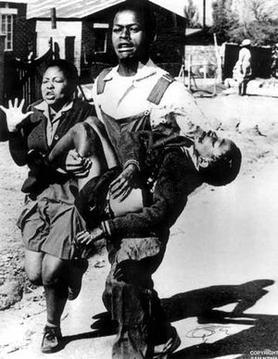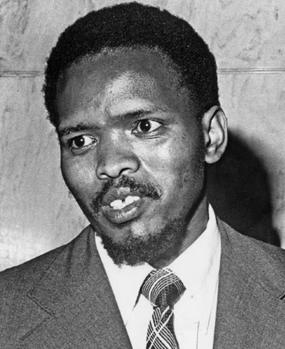Violence Reignites

12-year-old Hector Pieterson being carried away after being shot during the Soweto demonstration. (This is used under the fair use act. Info can be found here)
With many of the leaders of the anti-Apartheid movement now in jail, the movement splintered into various smaller groups with less coordination than before. One of the groups that had been trading in Angola decided to launch guerrilla attacks into South Africa from Angola in a war known as the South African Border War (1966-1989). These attacks had some coordination with the Angolan civil war and was also funded in part by communist leaders in Africa. While many of these rebels were South African, there were also a good deal of Angolans who were upset about the actions of South Africa in attempting to take some of their land in years previous.
It was during this era that the ‘Black Consciousness Movement,’ a black pride movement around Africa, really started to gain popularity around the world. This was sparked by a change in school curriculum in South Africa known as the Afrikaans Medium Decree (1974) in which all schools were directed to use Afrikaans language as their primary language. Many communities were horrified by this because this was seen as the language of the oppressor to many. These issues were on top of the fact that the government stopped providing funds for non-white education in the The Bantu Education Act 1953.
In response, children at Orlando West Junior School in Soweto went on strike over the language issues. This idea would spread to the other schools in the area and caused high school students to choose to have a rally against the policy. The police were called in response to this rally and they set up barricades before approaching. The students were funneled into a stadium using the barricades but the protest continued. The vast majority of students were peaceful but a few threw rocks at the police, who opened fire on the students in response. This quickly turned into a riot where police shot indiscriminately into the crowd, killing 23 black students. Two white people were also killed in the violence that has since become known as the Soweto Uprising (1976).
This became another of the major turning points in the fight for independence in South Africa. The idea that the police would open fire on children struck a nerve with people all over the globe. A 15 year old student by the name of Hastings Ndlovu became the icon for these killings and sparked a resurgence in protests and violence. A new younger group known as the South African Student Organization (SASO) was created and spearheaded numerous actions, both violent and non-violent. One of the young men that led this organization was Stephen Biko, who would go on to become one of the huge names of the anti-Apartheid movement (more on him soon). By the end of the first year of these renewed protests, riots would take the lives of 566 people and injure thousands more.
Many of the leaders of the renewed struggle were college students who had either been pushing for change for some time, or were moved into the struggle due to instances like the Soweto Uprising. Stephen Biko had been moving that way for some time prior to the Uprising, so much so that he was expelled from medical school for his political activities in 1972. He quickly moved into a leadership role and advocated the psychological liberation of the South African people by using the catch phrase “black is beautiful” which meant to inspire people that they aren’t beneath anyone because of their skin. While this phrase started in the US with post-Civil Rights Movement groups like the Black Panthers, he would become known for its use in writings and speeches. He was so popular and threatening to the powers that be that he would be banned by the government to speak to more than one person at a time. Obviously he broke this rule from time to time, but he picked his moments to do this.
Biko was arrested at a police roadblock which was screening for terrorists in 1977. He was ‘interrogated’ for 22 hours by the police before being put into a coma from the torture and dying in police custody. The government actually tried to claim that the injuries that led to his death were self-inflicted, but a year later the police admitted that they had killed him. When his death became worldwide news, the entire international community started to turn on the government of South Africa and pressure started to mount for them to fix this issue.

A picture of Steve Biko. (This is used under the fair use act. Info can be found here)
